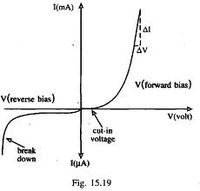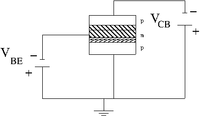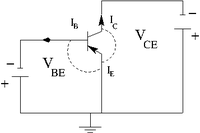Difference between revisions of "TF EIM Chapt5"
| Line 26: | Line 26: | ||
|} | |} | ||
| + | The bottom p-n junction, when forward biased, provides a large current with a small voltage bias. | ||
| + | |||
| + | The top half of the p-n-p transistor is reversed biased, providing a "throttle" for the large current from the lower half. | ||
The electric field point to the "collector" in the depletion region enlarged by the reverse bias. | The electric field point to the "collector" in the depletion region enlarged by the reverse bias. | ||
Revision as of 22:18, 7 March 2011
Bipolar Transistor
The Bipolar transistor concept
From the last chapter we saw a p-n junction diode which had similar characteristic current-vs- voltage responses when biased either in the forward direction or backward.
The bottom p-n junction, when forward biased, provides a large current with a small voltage bias.
The top half of the p-n-p transistor is reversed biased, providing a "throttle" for the large current from the lower half.
The electric field point to the "collector" in the depletion region enlarged by the reverse bias.
Transistor Physical features
The three layers
A transistor has three semi-conductor payers. The three layers occur in the order of
p-n-p= holes-electron-hole
n-p-n= electron-hole-electron
The three layers are formed from a single crystal such that the doping of the single crystal defines the boundaries. The three layers are not "glued" together.




